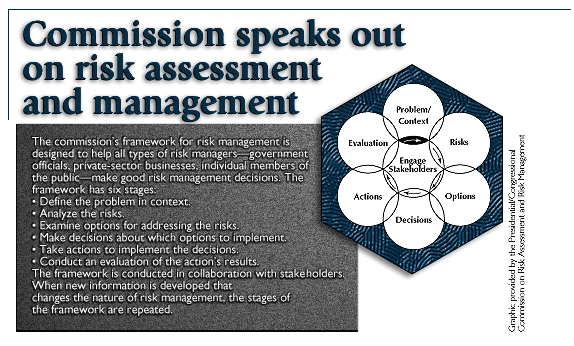

 After three years of hearings and meetings, the Presidential/Congressional Commission on Risk Assessment and Risk Management has released its two-volume report. The report is intended to improve federal agencies' often fragmented and cumbersome approach to risk management, which has resulted from a patchwork of laws enacted by various agencies over the last 25 years. The commission heard testimony from more than 100 individuals, including citizens who voiced concerns that risks are often minimized by not giving the full story, that future generations are not considered, and that public input and concerns are undervalued because people may lack advanced science credentials. The commission's report emphasizes the need to give risk management a broader scope than its traditional definition by looking not only at how regulatory options are selected, but also at how multiple aspects of the risk arena are integrated. The first volume of the commission's two-volume report, Framework for Environmental Health Risk Management, addresses the absence of a generally accepted framework for making complex risk decisions. It then puts forth a structure of guidelines and principles that provide an integrated, holistic, risk-based approach to protecting human health and the environment. Emphasis is placed on three areas: defining risks within broad contexts, involving stakeholders, and repeating the process as new information emerges. In addressing contexts, the commission promotes comprehensive, multimedia (soil, water, and air) risk management that looks at cumulative risks from multiple pollutants and multiple sources, instead of assessing risks of a single chemical in a single medium. Stakeholders are recognized as often having important knowledge of sources and patterns of exposure that analysts need to integrate into a risk assessment. Iteration, or revisiting earlier phases of the risk management process, is critical to incorporate the discovery of new information. "We propose a systematic, comprehensive framework that...keeps the focus on the risk management goal-risk reduction and improved health status," states the commission in Volume 2's executive summary. The 60-page Framework (Volume 1) is reader friendly and is designed to reach a broad audience ranging from government officials to scientists and members of the public. It includes many real-world examples of successful and unsuccessful approaches, pointing out pitfalls of traditional approaches and arguing the merits of using the approach suggested in the Framework. Volume 2, Risk Assessment and Risk Management in Regulatory Decision-Making, addresses specific findings and discusses tough issues, such as realistic exposure scenarios, limitations of economic analyses, relevance of animal toxicity studies to humans, and other risk issues under debate. It emphasizes the need to consider risk assessment both before and after cleanup and advises that economic benefits should not be used as the overriding determinant of regulatory decisions. The volume then offers specific recommendations to the U.S. Environmental Protection Agency, the U.S. departments of Energy and Defense, the Occupational Safety and Health Administration, and the Food and Drug Administration. For DOE, two major findings were specifically identified by the commission-one on the risk-based nuclear weapons site cleanup and the other on worker safety. The commission views positively DOE's recent effort to link budget and programmatic decisions to risk reduction priorities, although the commission comments that the definitions of those evaluations are "somewhat uncomfortable and cumbersome." The commission recommends that DOE's Office of Environmental Management continue to assess and manage its program from a risk perspective. The commission also encourages others to examine EM "as a model for EPA's Superfund program." Regarding worker safety, the commission recommends that DOE develop a process that integrates worker risk into DOE's decision-making regarding the choice and timing of remediation options. At the same time, the commission recognizes the challenges of balancing short-term worker risks with much longer-term community risks in cleanup decisions. "I think this report will be a milestone in how to do risk assessment and will certainly be useful within DOE," said Rogene Henderson, senior scientist at the Lovelace Respiratory Research Institute (formerly DOE's Inhalation Toxicology Research Institute) and chair of the National Academy of Science's Committee on Toxicology. She noted that the report was laudatory of DOE approaches to bringing stakeholders into the risk assessment process. "DOE needs to continue along that line and integrate risk assessment as a part of risk management and cleanup decisions." Copies of the report may be obtained by faxing a request to the Presidential/Congressional Commission on Risk Assessment and Risk Management at (202) 233-9540, calling (202) 233-9537, or visiting the Riskworld Web site at http://www.riskworld.com. |